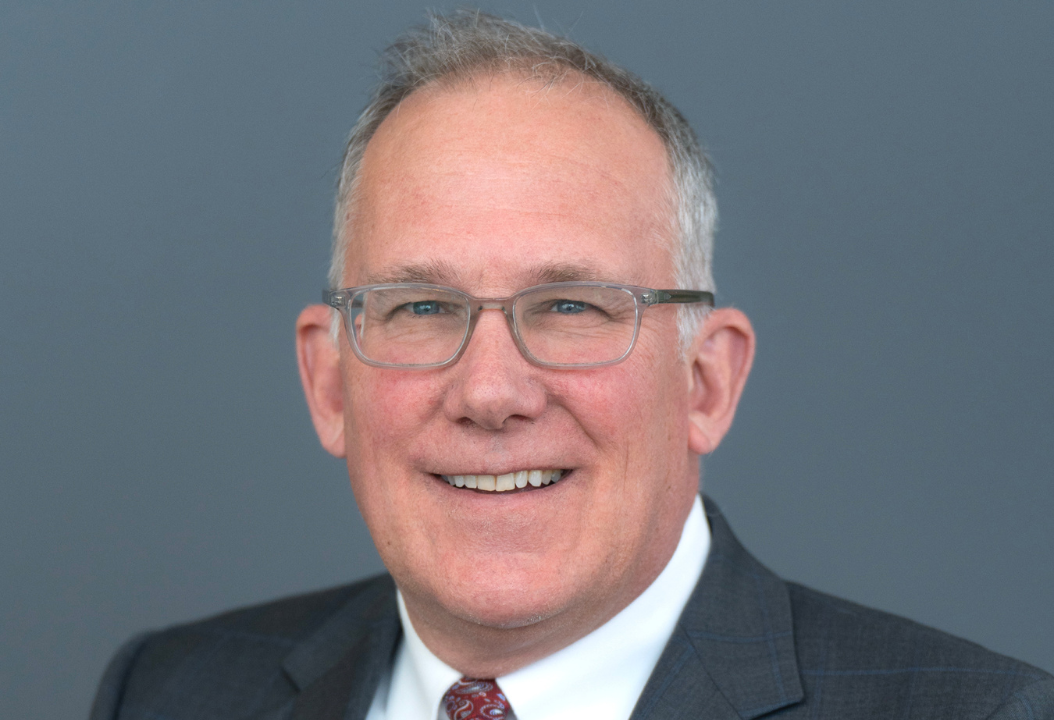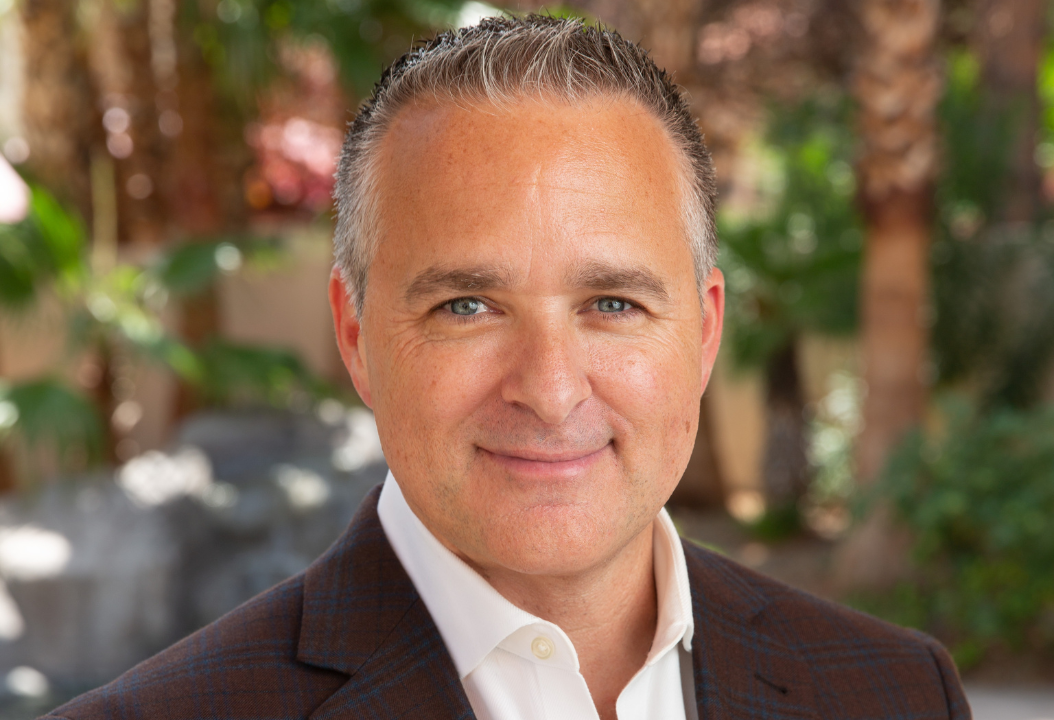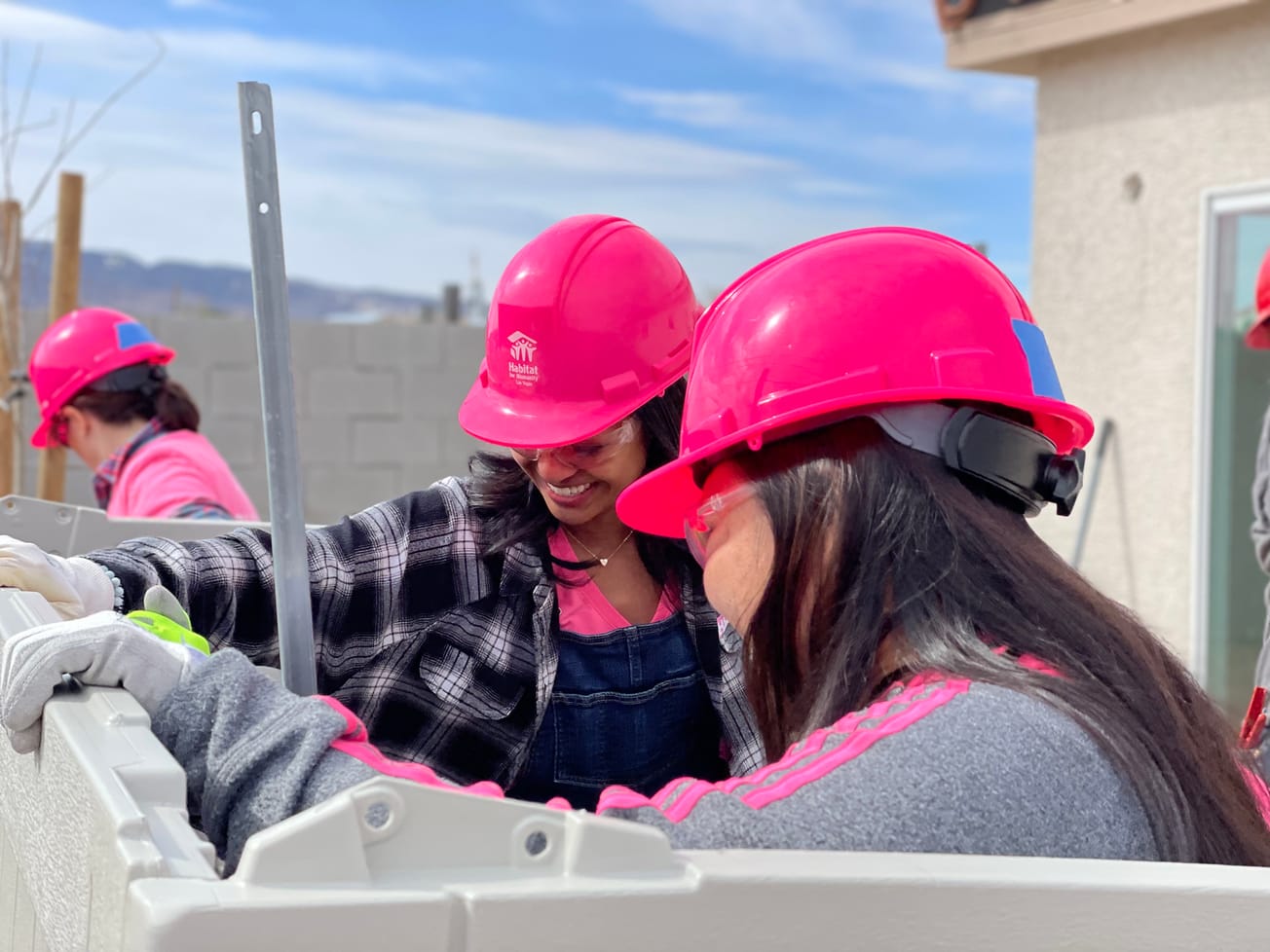Subscribe to our email newsletter and follow us on social media.
Last week, the Las Vegas Global Economic Alliance (LVGEA) hosted its 42nd annual Las Vegas Perspective at The M Resort. This year's theme was "Sustainable Economic Development". The event started with an opening remarks by LVGEA President & CEO Tina Quigley, and she outlined the region’s main issues moving forward: land, workforce/talent, and water. With the finite amount of water, developable land, and natural resources in Southern Nevada, we need to think about our growth plan more strategically. What kind of jobs do we want to create? What kind of businesses do we have here? What kind of talent pipeline should we build here?
Workforce & Higher Education
The first speaker was Dr. DeRionne Pollard, President of Nevada State College. She emphasized that economic development is an ecosystem, with workforce and higher education being two elements of that larger ecosystem.
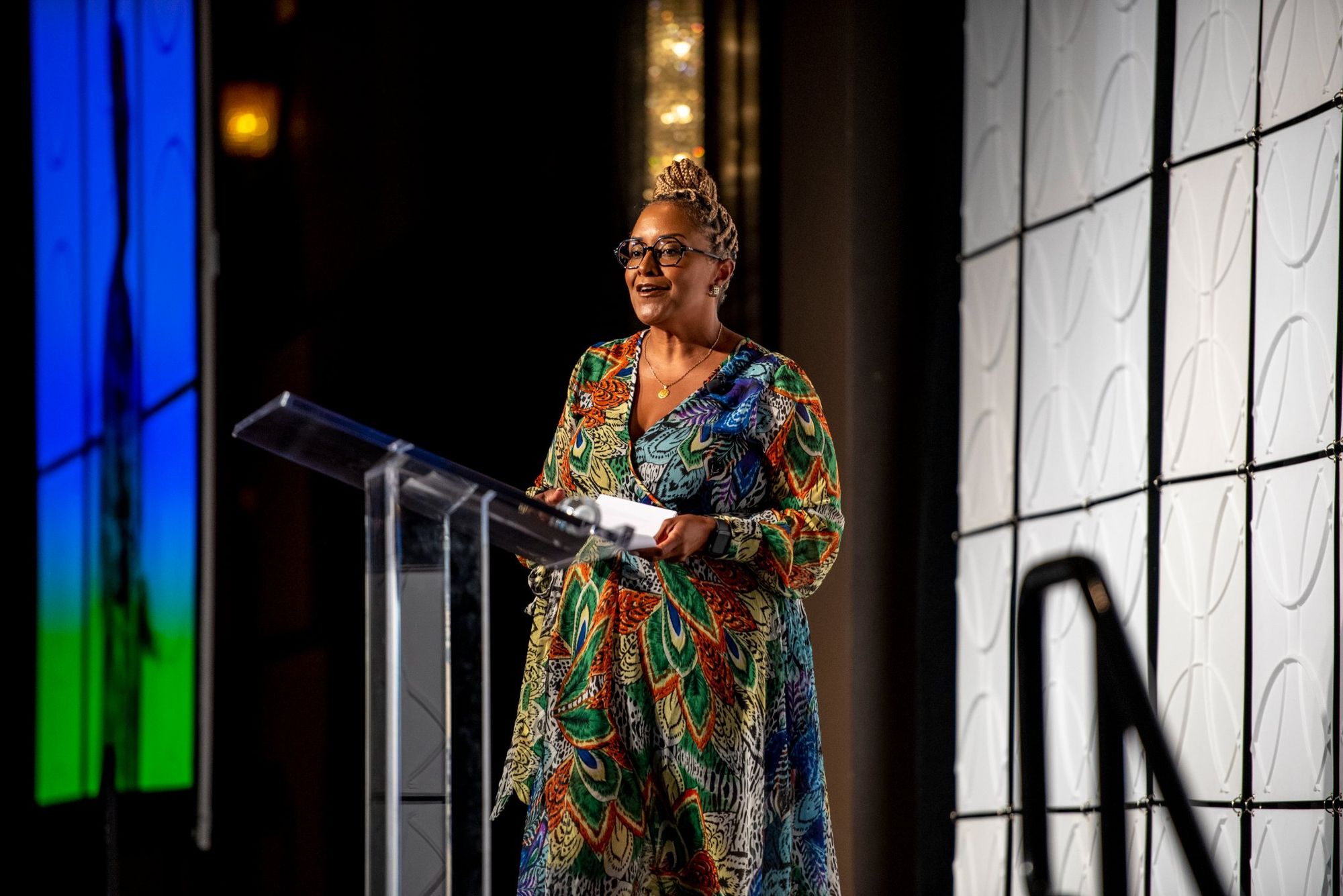
Dr. Pollard used Amazon’s second headquarter project in Northern Virginia as an example on how "education is the factor" when businesses make their decision on there to relocate or expand. According Amazon’s Northern Virginia’s HQ2 proposal, “Greater Washington is the country’s most educated region (~49% fo those 25 and older have at least a bachelor’s degree), and it produces more computer science graduates than any other metropolitan area.”
So do we get the businesses to move here first so we can attract the workforce, or do we develop the workforce here first so we can attract the businesses? Dr. Pollard believes that we can do both at the same time.
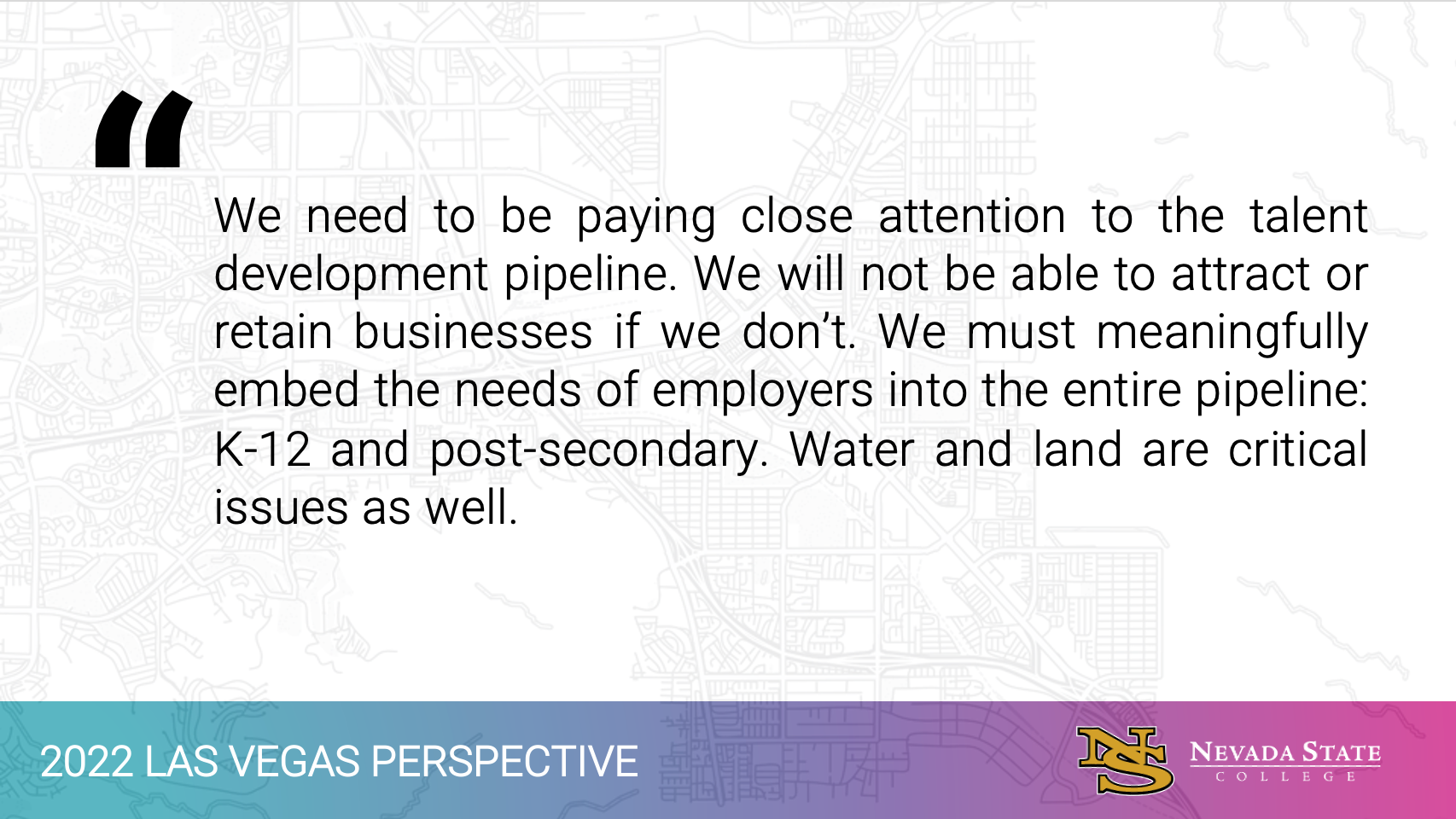
The key action here is to invest in education.
"Prior to the pandemic, we know where Southern Nevada ranked nationally in education outcomes, workforce readiness, infrastructure, etc," said Dr. Pollard. "Now, we have an opportunity to use unprecedented federal funds to completely change our region’s future! We must have the courage to make strategic long-term people-based investments unattractive to our credit seeking officials who want the quick win and twitter press release. Similar federal dollars flowed into the regions we compete against, and you better believe our competitors will make smart investments that will widen the gulf between us and them if we are not purposeful and intentional in our strategic choices."
These slides below show that Florida is investing over $3 billion in higher education and Texas is investing $325 million to its Higher Education Coordinating Board for the purpose of university construction.
And how much is Nevada investing in higher education? The answer is "not enough."
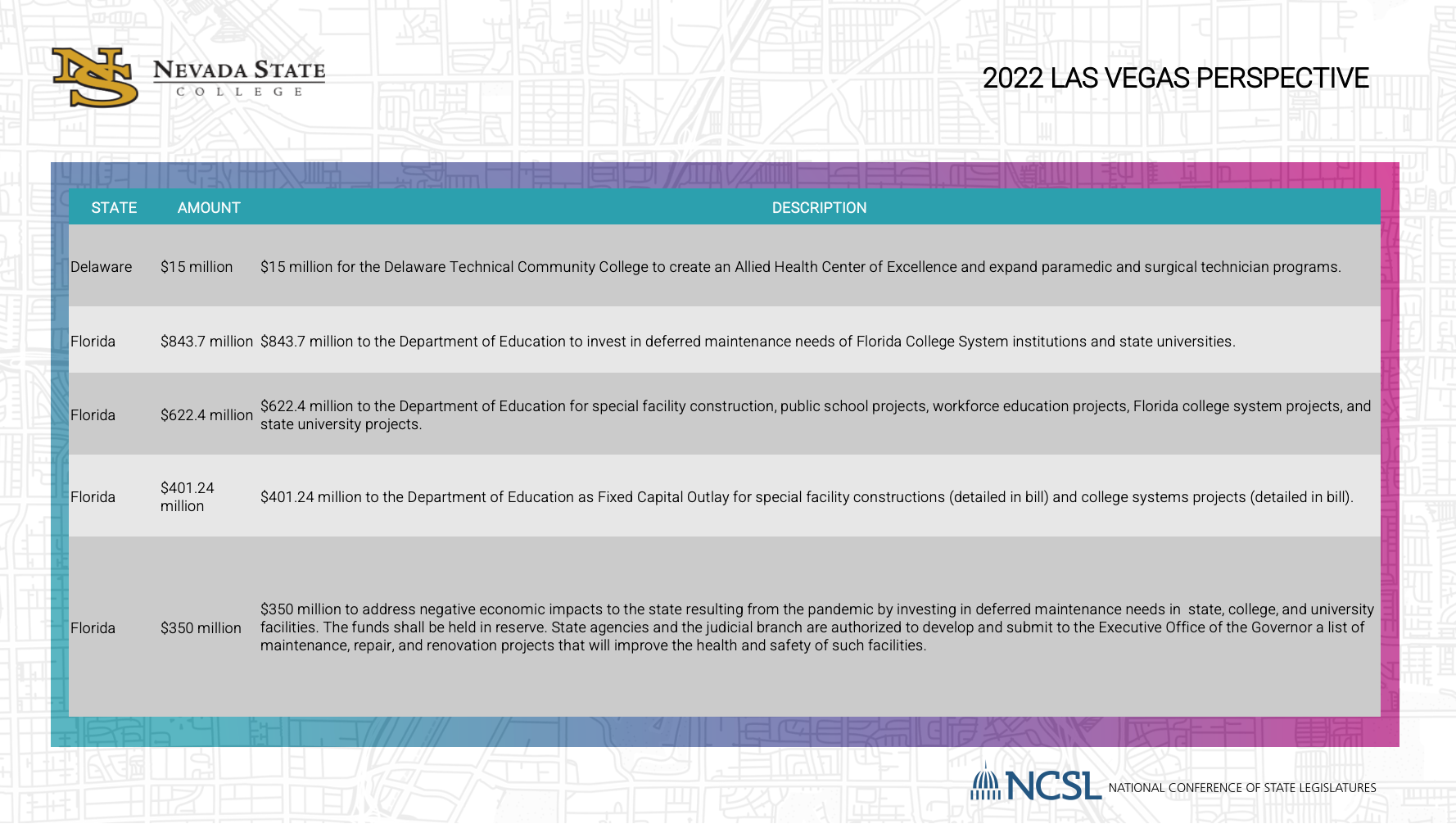
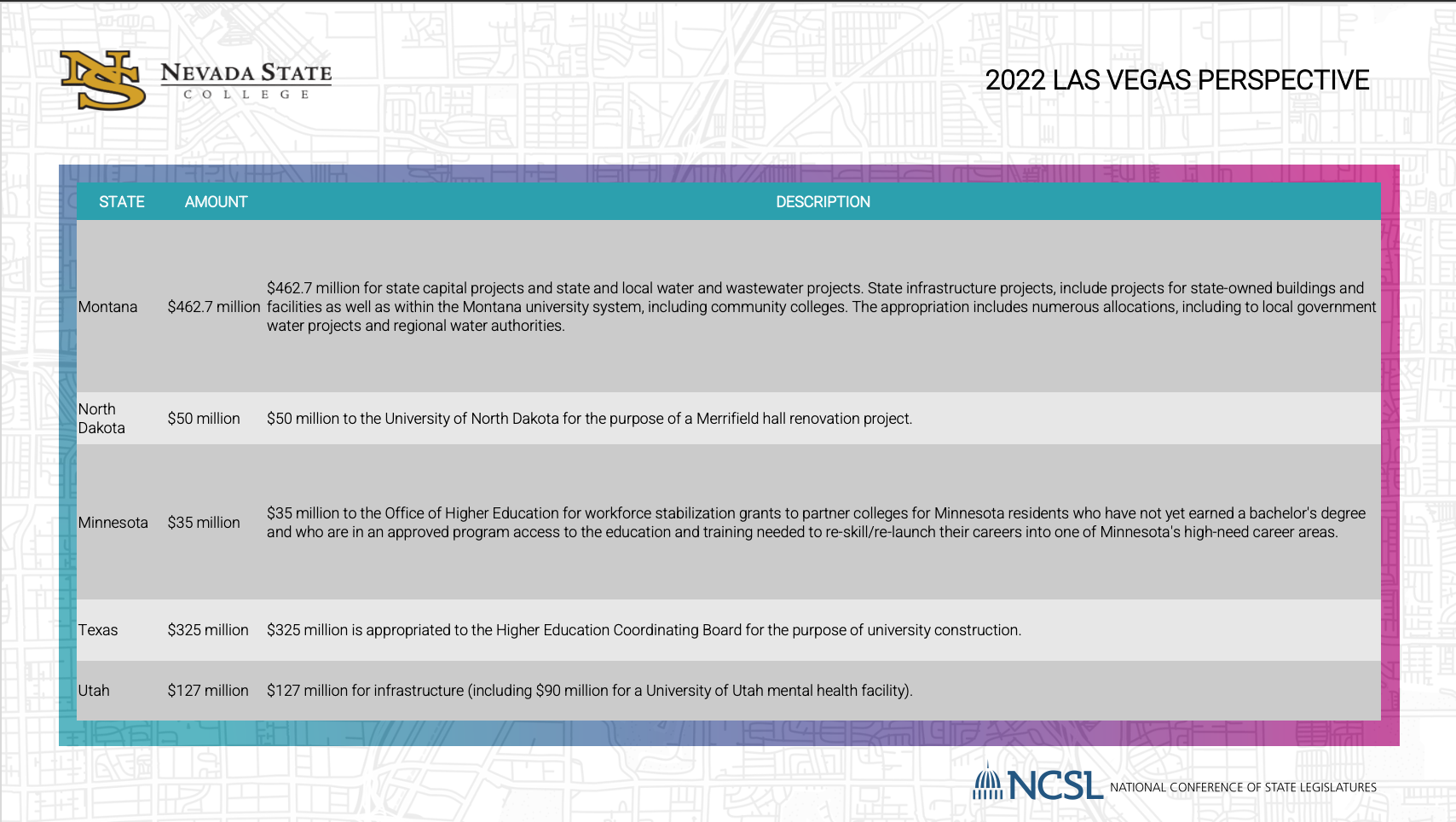
Water
The next speaker was Cindy Wallis-Lage, Executive Director of Sustainability and Resilience for Black & Veatch, a $3 billion employee-owned engineering, procurement, consulting and construction company with a more than 100-year track record of innovation in developing and delivering sustainable infrastructure. She discussed water security and its importance to economic growth.
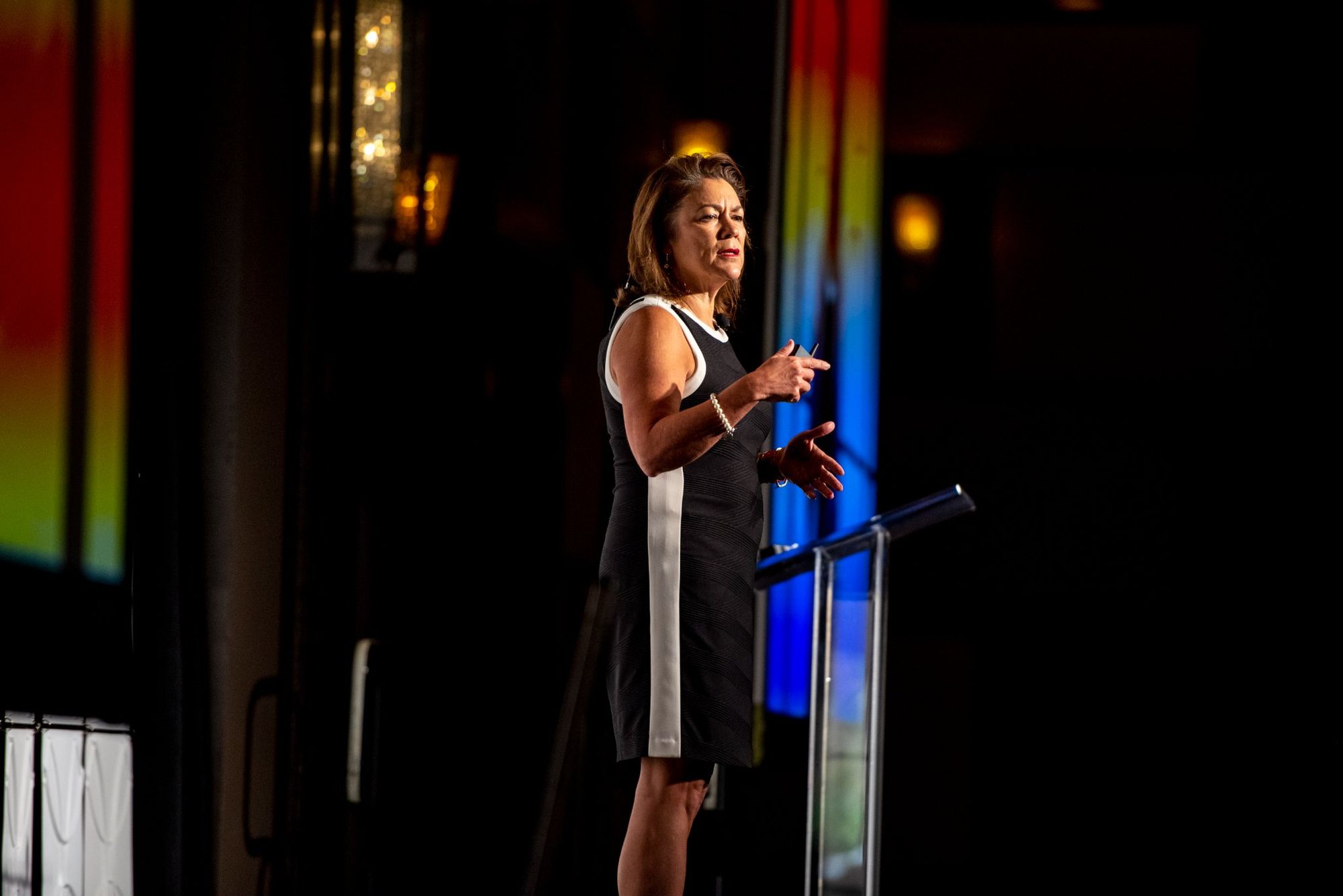
"What got us here, won't get us there."
“What got us here, won’t get us there,” said Wallis-Lage. “The reality is, things are changing, and we have to change with it. I use the word, ‘drying climate,’ and that’s intentional. Because when we say drought, we’re saying we think this will end. We’re saying we’re going back to where things were. And that’s not the case. We have a new normal.”
The chart below from Applied Analysis and Southern Nevada Water Authority shows the sources of where the water is being used in Southern Nevada. 45.6% of the water being used in Southern Nevada is at residential single-family homes, 16.3% is being used at multi-family apartments, and 13.2% is being used in commercial and industrial buildings, 4.9% is being used in resorts, 5.5% is being used in golf courses, and the remaining amount is being used in schools, government buildings, parks, common areas, and other.
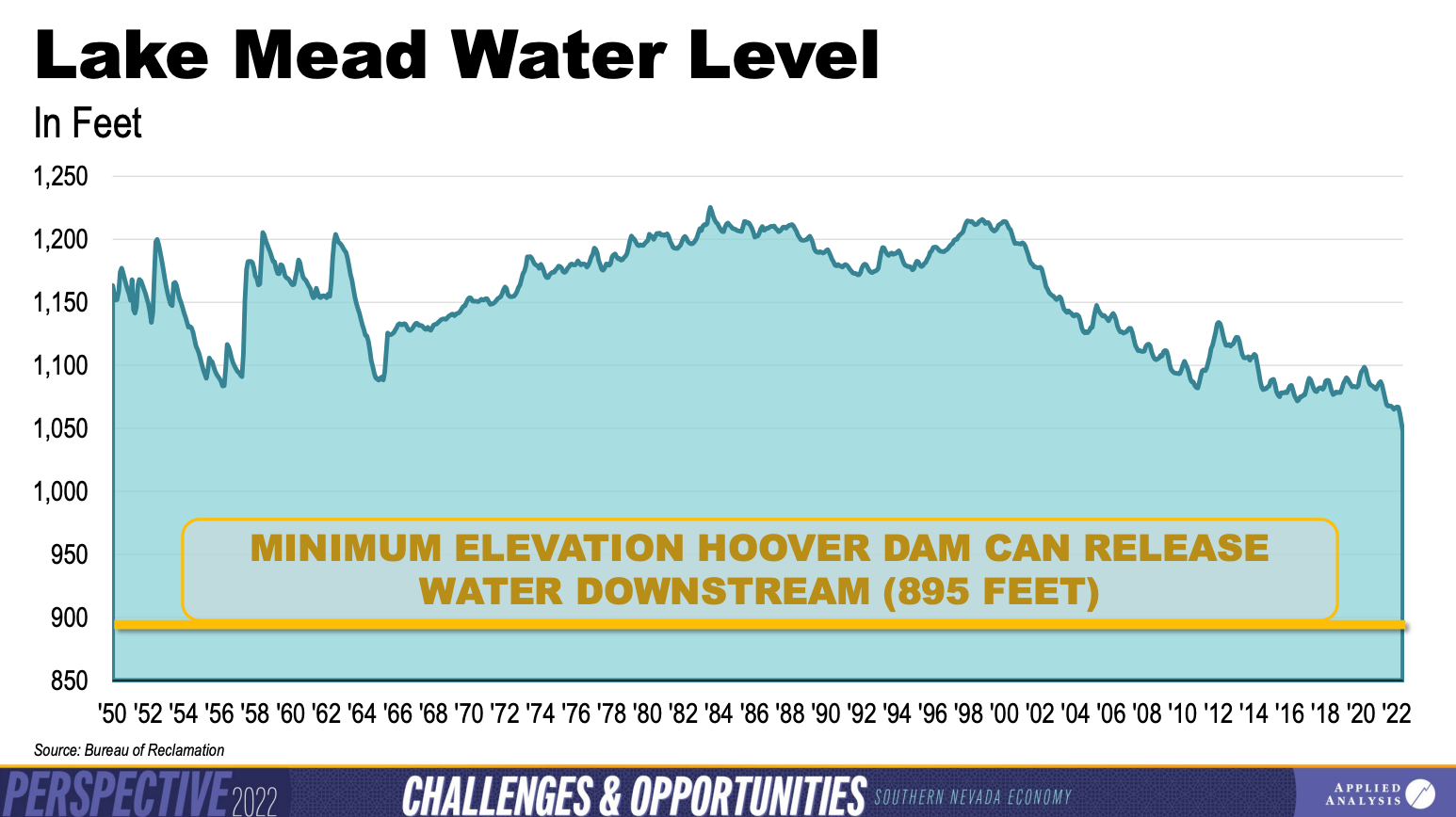
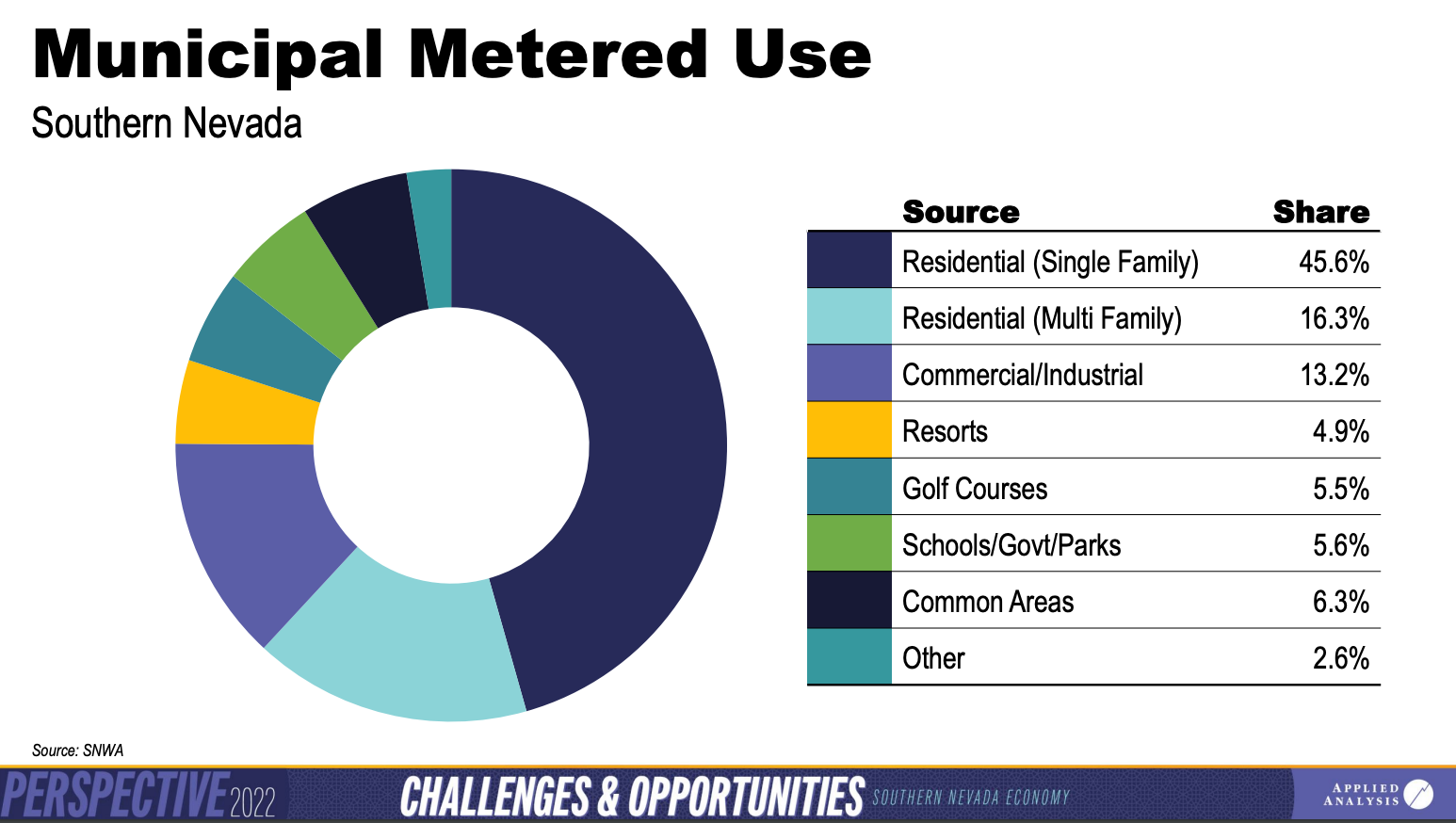
Less Gallons Used Per Capita
Although our population has been growing, but we are using less water per capita compared to the 20 years ago. New residential construction is more energy & water efficient, so new homes use less water than old homes. Annual residential water used in 2019 was 36.8% less than in 1989.
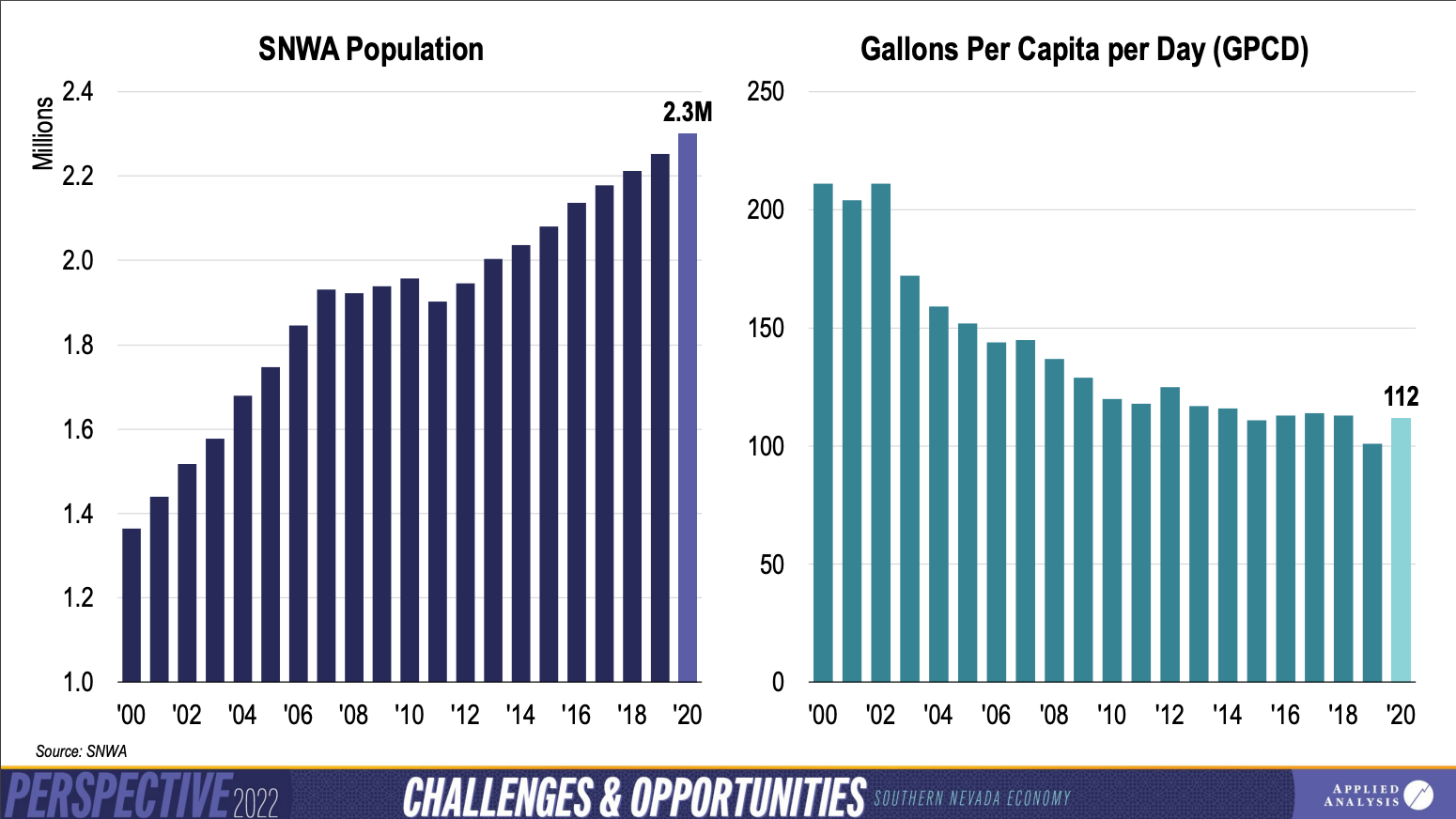
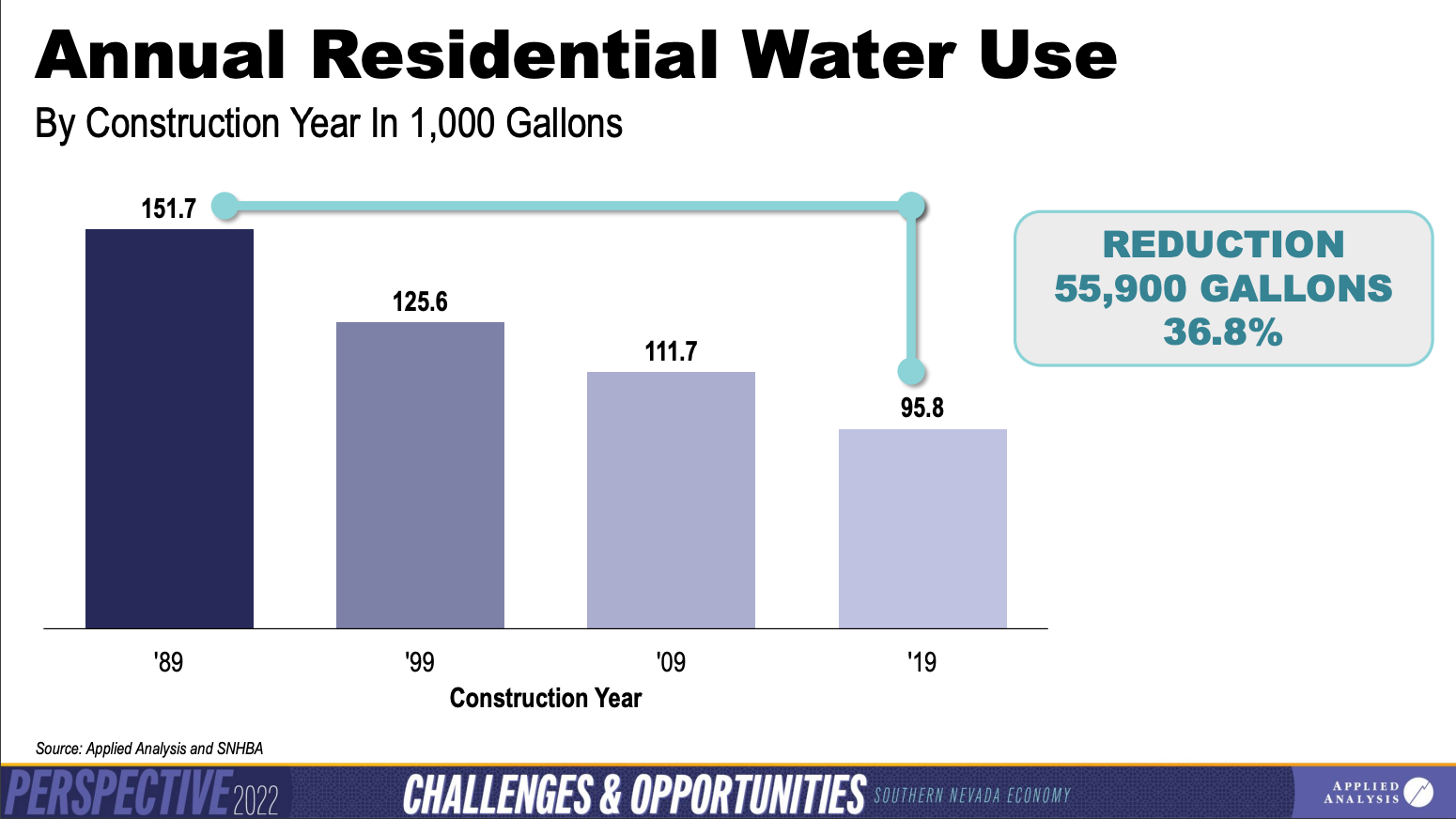
Earlier this year, we covered LVGEA's State of Economic Development event and talked about water insecurity.
According to the Las Vegas Valley Water District, the community used 24 billion gallons less water in 2020 than in 2002, despite a population increase of more than 780,000 residents during that time. This represents a 47 percent decline in the community’s per capita water use since 2002.
- Recently, the Nevada Legislature passed a law prohibiting the use of Colorado River water to irrigate unused, decorative grass around business complexes, along streets in HOA communities, and in traffic circles and medians by the end of 2026. The Southern Nevada Water Authority offers a rebate to help cover costs of removal.
- The community is following a mandatory watering schedule for landscape.
- For both City of Las Vegas and Clark County, no new turf is allowed in front years on single-family homes.
- Since 2004, existing golf courses have operated under strict water budgets set by the Las Vegas Valley Water District. Southern Nevada golf courses have replaced 900 acres of turf with desert landscaping and invested in water efficiency and management projects.
Although we are taking actions on the water issue, but it is not enough. We definitely need to do a lot more at the public and private sectors to ensure water security in Southern Nevada.
Land & Housing
Brian Gordon, Principal of Applied Analysis, talked about the challenges and opportunities we are facing in Southern Nevada. Two of the challenges are lack of developable land and affordable housing.
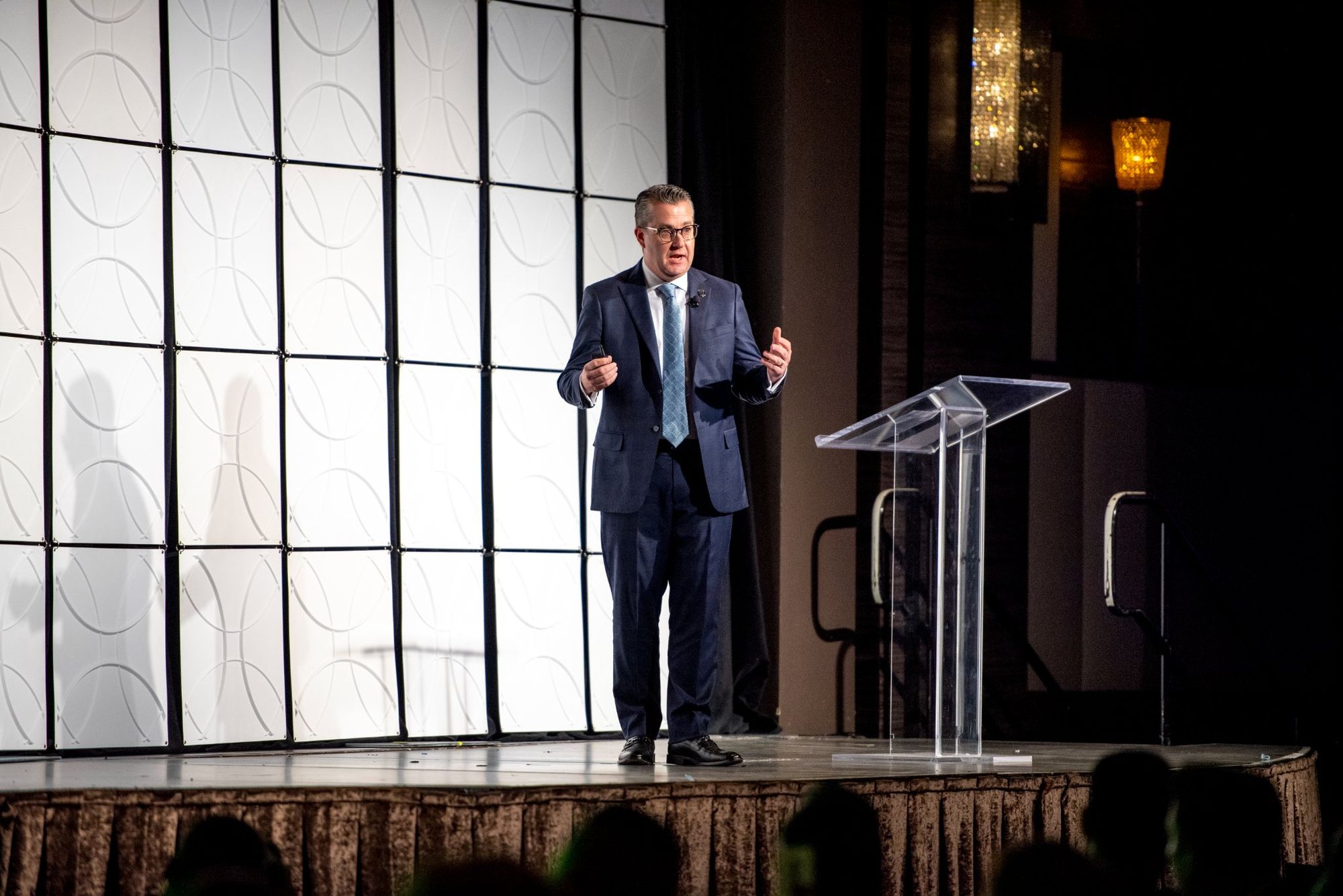
As population continues to growth in Southern Nevada, lack of developable land is a main concern. About 81% of the land in Nevada are owned by the federal government. Nevada ranked second in the nation in federal land ownership. Scarcity of private, developable land continues to push land and home prices to go up. U.S. Sen. Catherine Cortez Masto introduced S567 - Southern Nevada Economic Development and Conservation Act to "protect over 2 million acres of public land for conservation and recreation while allowing Clark County to develop affordable housing and responsibly plan for population growth" (S567).
One of Gordon's presentation slide shows "The market’s ability to meet future demand will be limited by the sufficiency of vacant developable property…Clark County has approximately 11 years of effective land availability remaining."
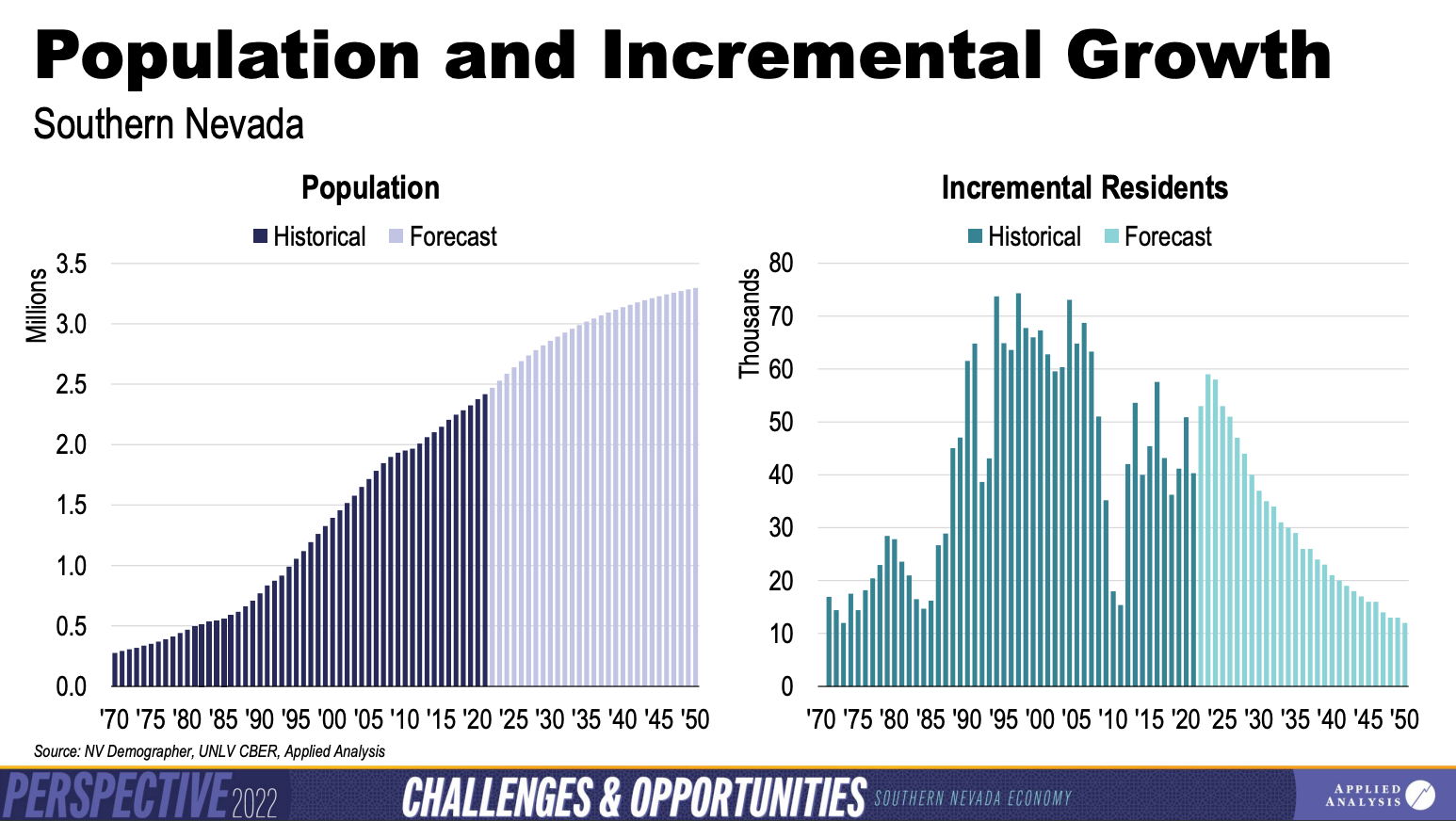
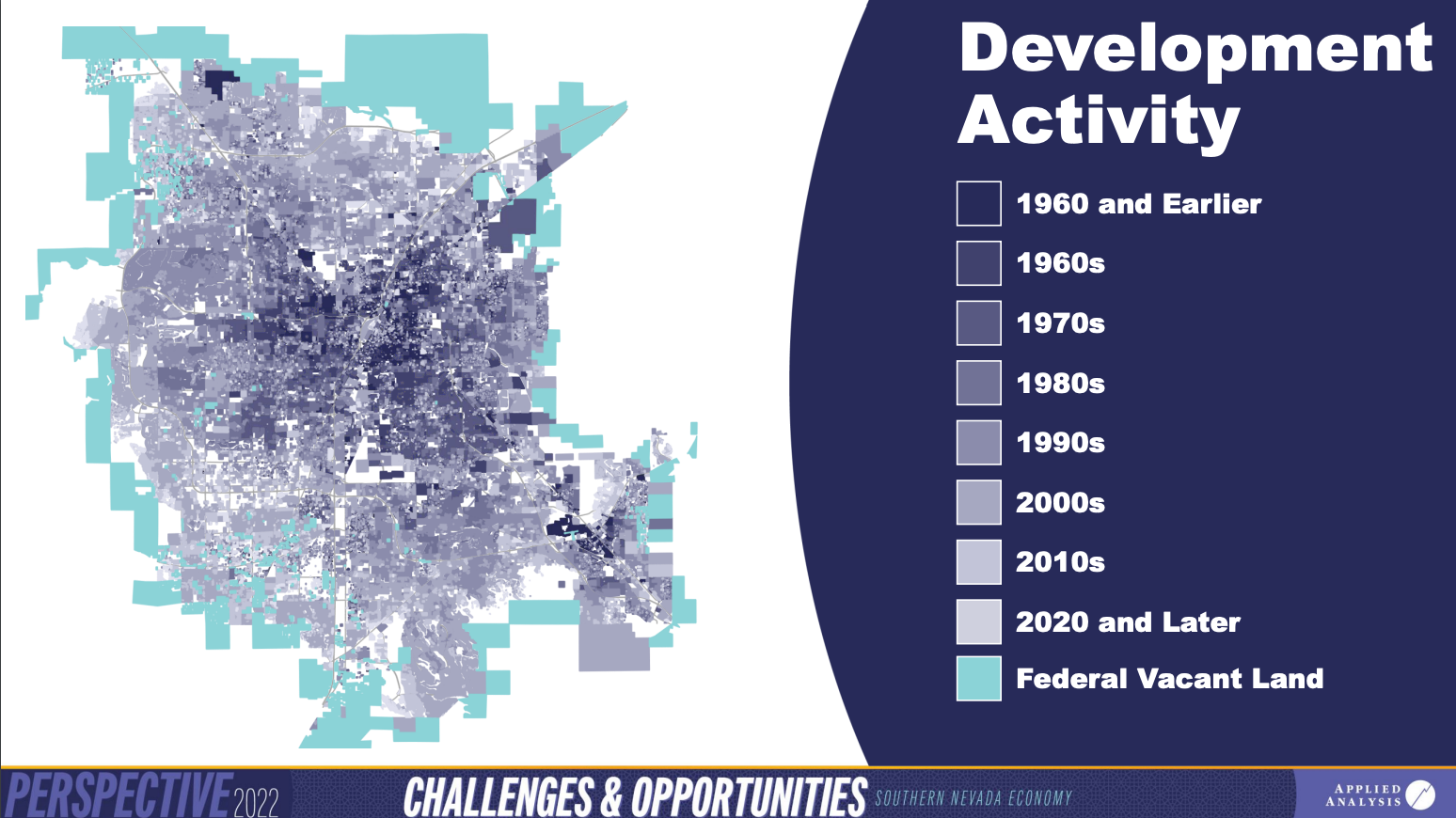
"Home Means Nevada"
The National Association of Homebuilders Housing Opportunity Index (HOI) shows that housing affordability in Las Vegas MSA has been decreasing. Hourly wage to afford a two-bedroom rental room in Las Vegas is $22 per hour.
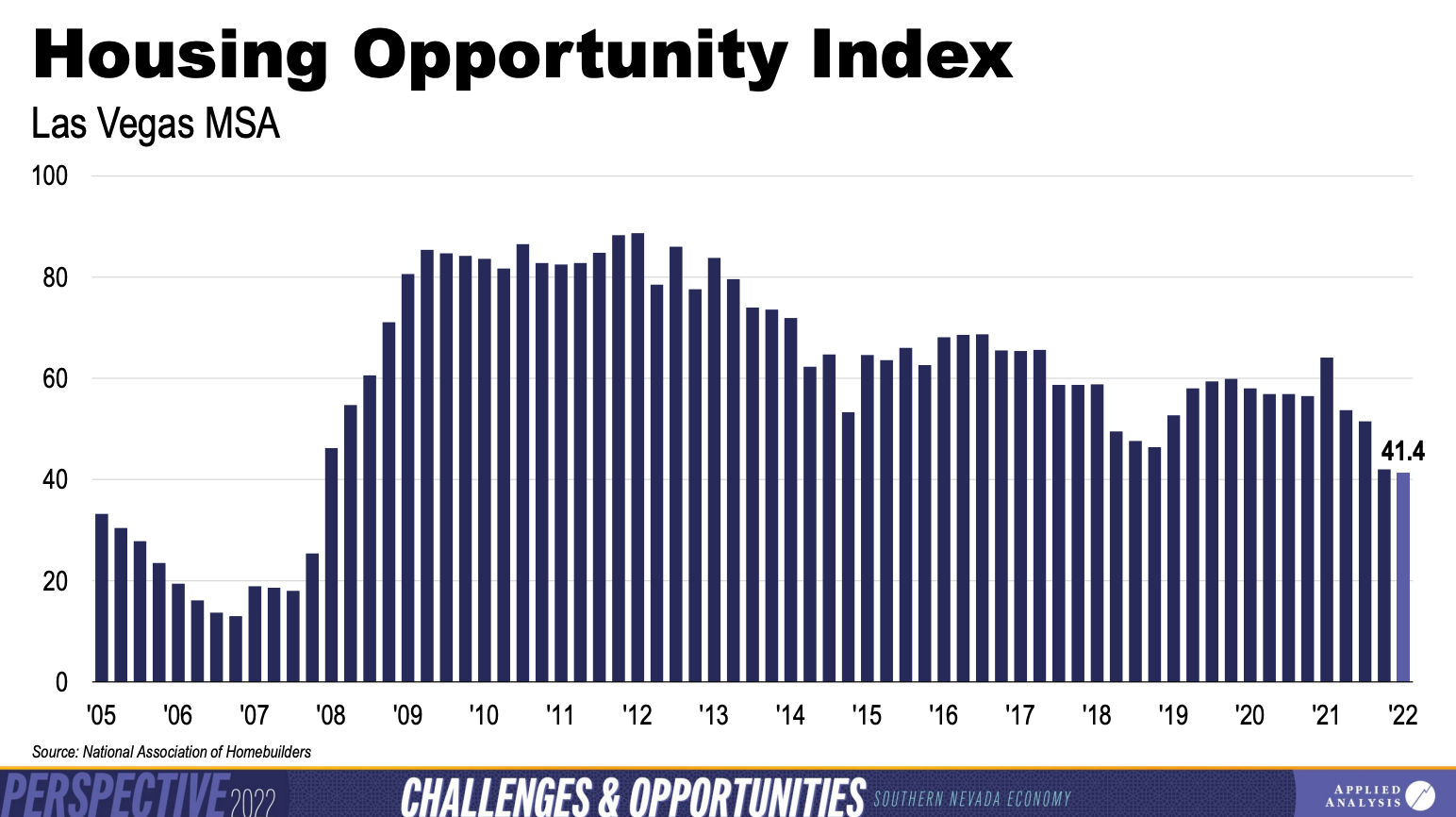
This year, Nevada launched a $500 million affordable housing initiative as part of the federal American Rescue Plan dollars. The Nevada Housing Division will invest $500 million, along with other forms of available debt financing programs such as Low-Income Housing Tax Credits (LIHTC), to lower the cost of housing, help seniors make repairs and accessibility retrofits to stay in their homes, and boost housing availability.
We published an article two months ago about how Southern Nevada is fighting the affordable housing crisis at the state, county, and city levels.
Diversifying Our Economy
Gordon noted that with inflation at a 40-year record high, the one word on everyone’s mind is ‘recession.’ “Things are moving very quickly,” said Gordon. “Just a few months ago, a survey of economists showed only 28% predicted a ‘hard’ landing for the economy, whereas today that number is 80%. Things are changing rapidly, and I think that’s why we’re all feeling a little bit of this economic uncertainty.”
Las Vegas' economy heavily depends on the tourism industry. The region has been diversifying its economy since the 2008 recession. When the next recession comes, are we ready to face another economic downturn?
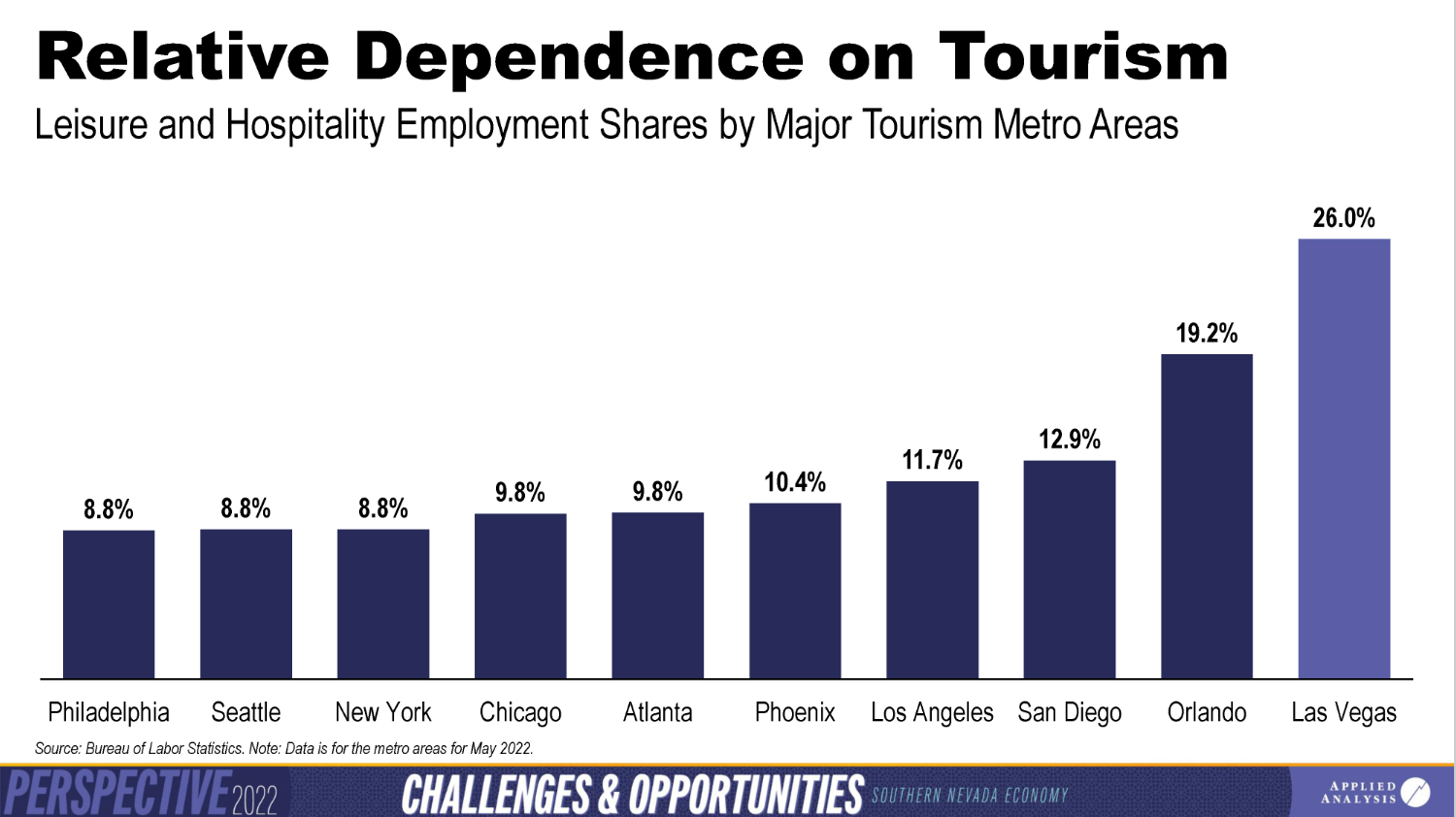
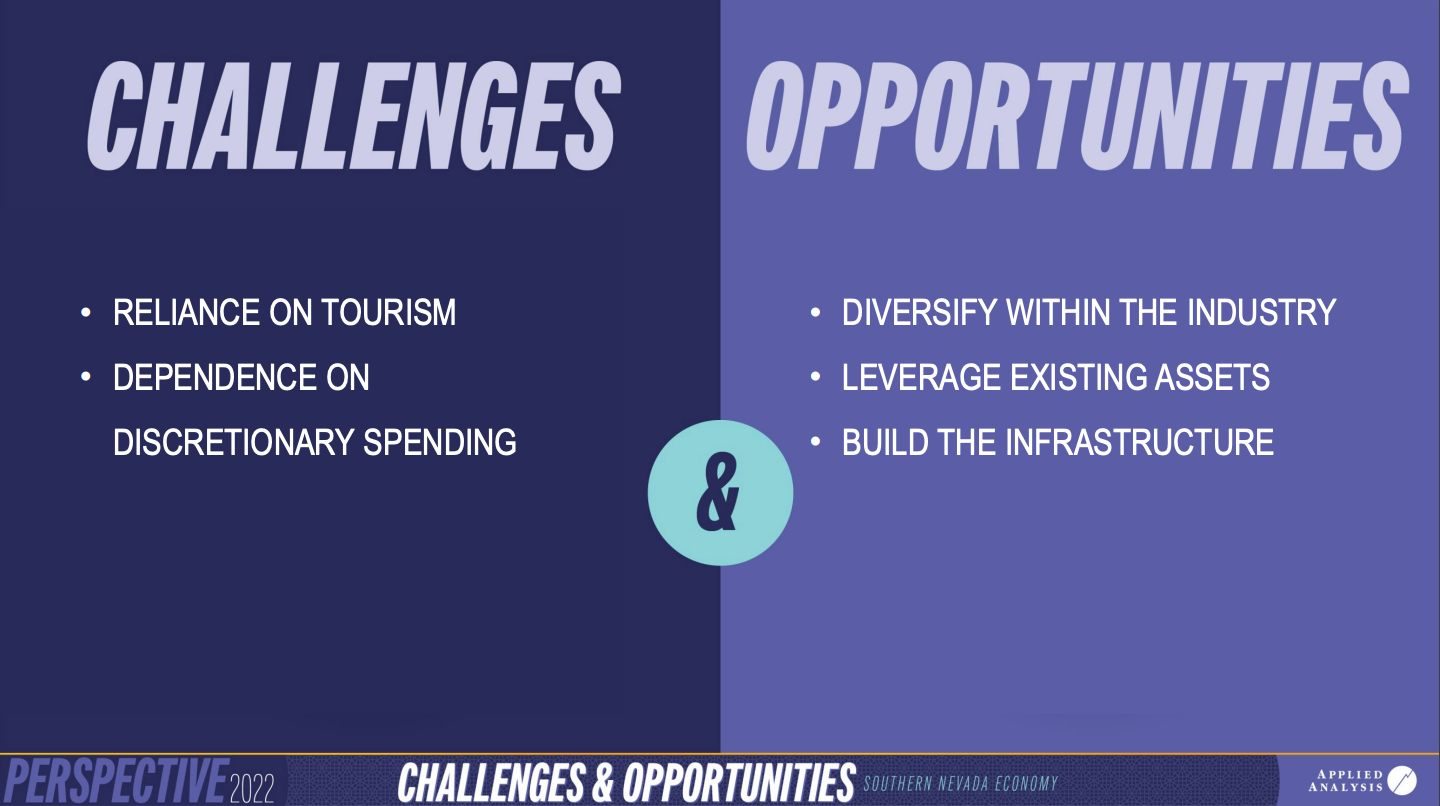
New Sports Hub in America
Southern Nevada is becoming the next big sports hub in America. With the Allegiant Stadium, T-Mobile Arena, the new Dollar Loan Center, and a proposed NBA Arena & Resort by Oakview Group, Southern Nevada has the infractures to host national and international sports events.
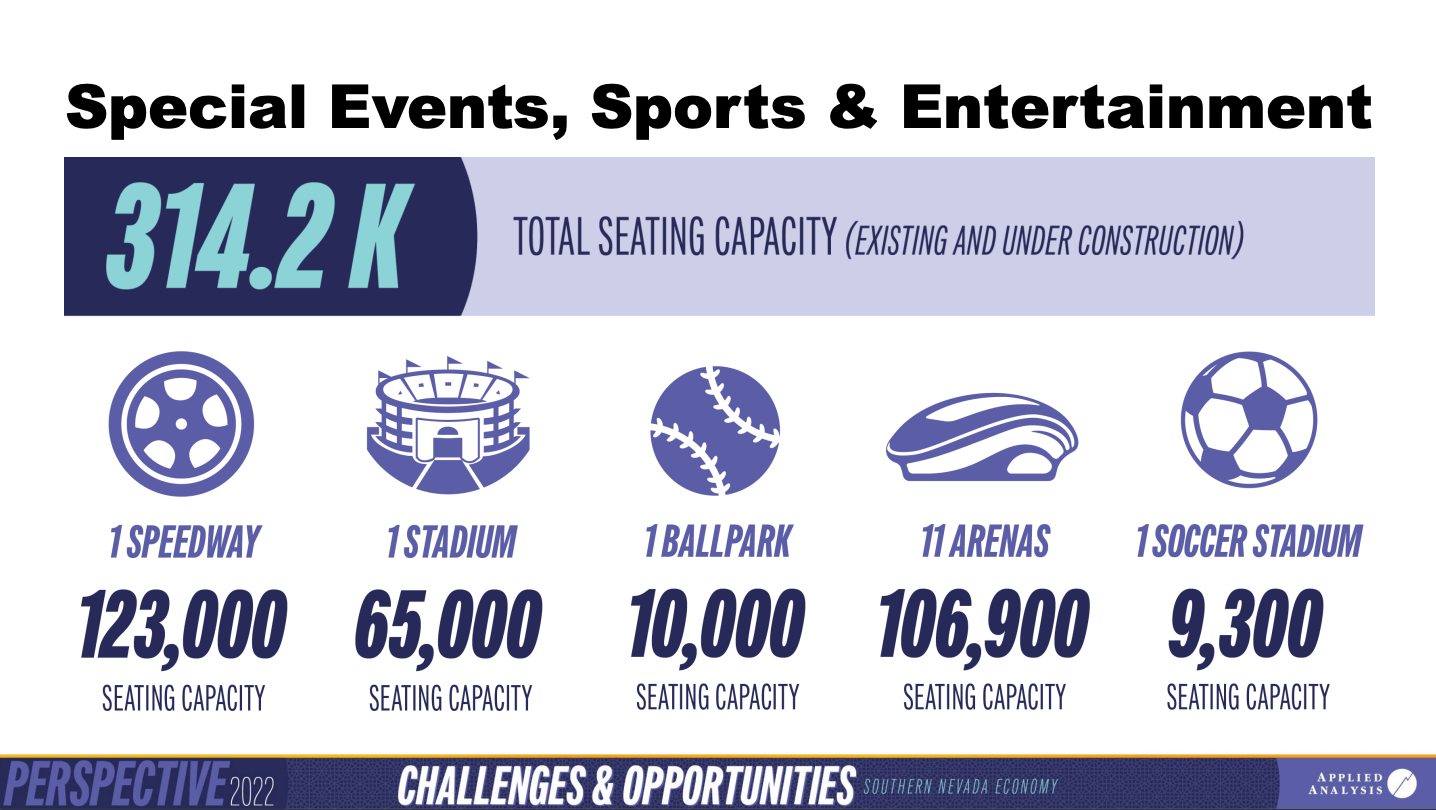
F1 announced earlier this year to host Las Vegas Grand Prix starting in 2023. F1 is one of the fastest growing sports in America in terms of viewership. In May this year, the Miami Grand Prix at the Hard Rock Stadium saw 242,955 attendees over the three days period with a record 85,280 people on race day, per the race's official Instagram page. Last month, F1 acquired 39 acres of land east of the Las Vegas Strip for $240 million.


Employment Growth by Sector
To diversify Nevada's economy, the Governor’s Office of Economic Development is focusing on a few targeted industries such as advanced manufacturing, logistics & operations, information technology, and health & medical services. During the pandemic, many of labors left the workforce and never returned.
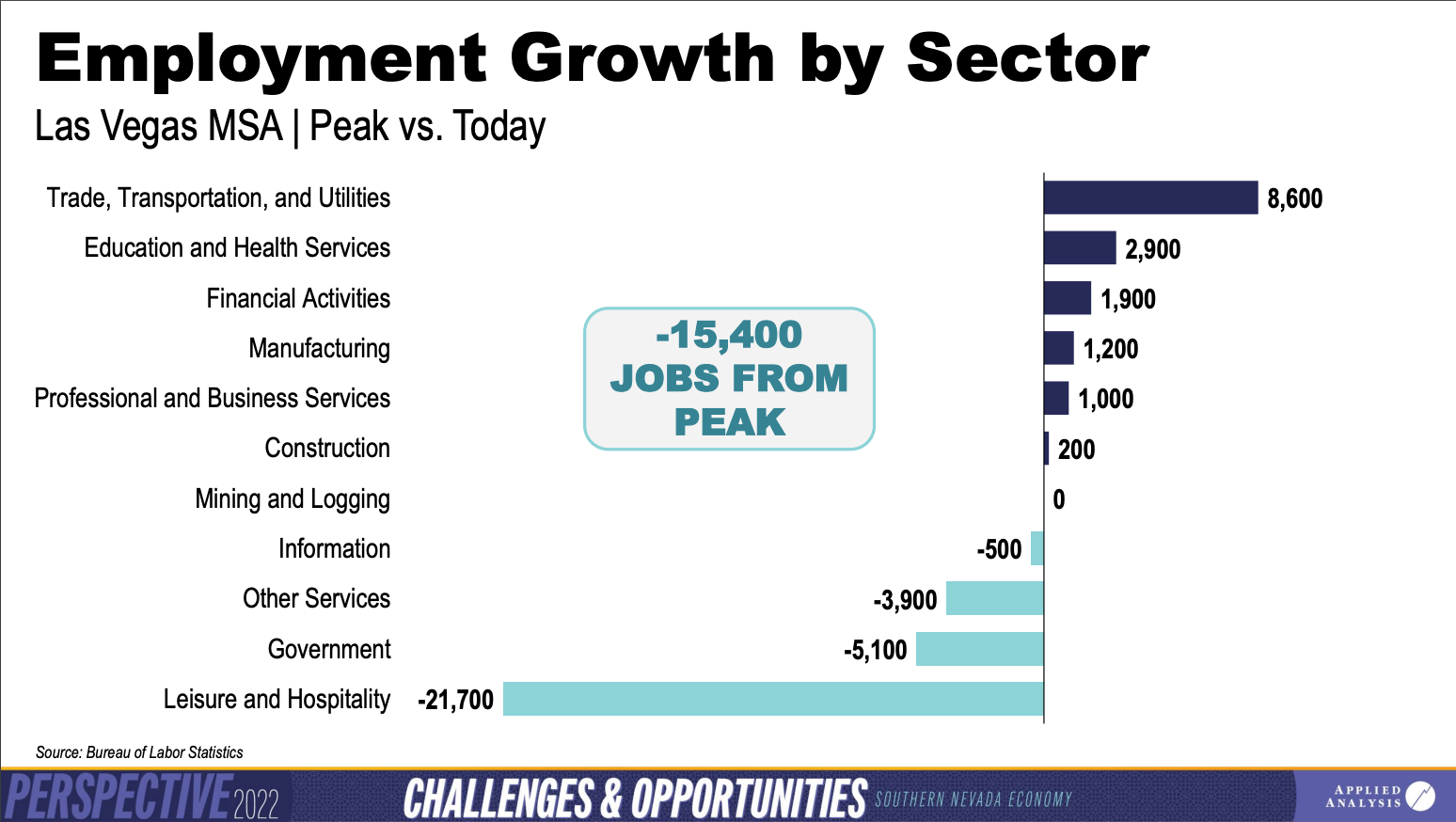
Las Vegas has learned our lesson in 911, 2008 and 2020. Our economy cannot heavily depends on the leisure and hospitality industry forever. We must diversify our industry in order for our city to growth more sustainable in the long term. We cannot have a boom and bust every 10 to 12 years with the market cycle.
“This is the time for our community to grow up,” said Gordon. “We’ve made great strides, but we’re not there yet. It’s time to make bold decisions and move the economy forward. It’s time to start acting our age.”
Subscribe to our email newsletter and follow us on social media.


